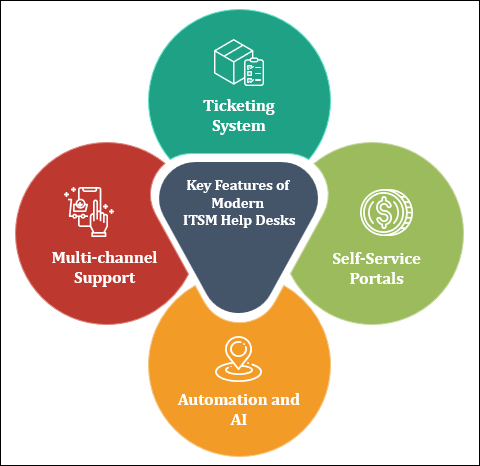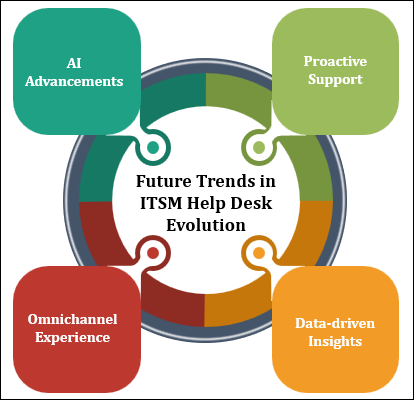ITSM HELP DESK
In today's fast-paced digital landscape, where businesses and individuals rely heavily on technology for their day-to-day operations, Information Technology Service Management (ITSM) has emerged as a crucial framework for ensuring the efficient delivery of IT services and support.

At the heart of ITSM lies the Help Desk, a pivotal service that bridges the gap between technology and users. This blog post delves into the evolution of ITSM Help Desks, exploring their significance, key features, challenges, and future trends while also highlighting the ever-growing need for seamless customer support and operational excellence.
The Significance of ITSM Help Desks
ITSM Help Desks serve as the primary point of contact for end-users experiencing technical issues, questions, or seeking guidance regarding various technology-related matters. Their significance spans multiple dimensions:
- Customer Support: One of the central functions of an ITSM Help Desk is to provide exceptional customer support. By addressing user concerns promptly and effectively, Help Desks play a pivotal role in enhancing user satisfaction and fostering customer loyalty.
- Issue Resolution: Timely issue resolution is essential to minimizing downtime and ensuring uninterrupted business operations. Help Desks facilitate the prompt identification and rectification of technical problems, contributing to enhanced productivity and operational efficiency.
- Knowledge Management: An effective Help Desk is also a repository of knowledge. It creates, curates, and shares knowledge articles and resources that empower users to troubleshoot common issues independently. This not only reduces the burden on support staff but also empowers users to resolve problems proactively.
- Communication Hub: Help Desks act as a central communication hub, facilitating clear and consistent communication between IT teams and end-users. This communication is crucial for both parties to understand issues thoroughly and work together toward resolution.
Key Features of Modern ITSM Help Desks
The evolution of ITSM Help Desks has led to the integration of numerous features that enhance their functionality and efficiency:
- Multi-channel Support: In today's era of diverse communication channels, Help Desks offer support through multiple mediums such as email, phone, live chat, and even social media platforms. This flexibility empowers users to choose their preferred method of interaction.
- Ticketing System: A robust ticketing system is a hallmark of modern Help Desks. It enables the systematic tracking and management of user issues from the point of creation to resolution. This approach ensures that no issue goes unnoticed and provides transparency throughout the support process.
- Self-Service Portals: Self-service portals are a cornerstone of efficient Help Desk operations. These portals offer users a wealth of knowledge articles, frequently asked questions (FAQs), and step-by-step guides, enabling them to troubleshoot common problems independently. This reduces the influx of basic queries and enables support teams to focus on more complex issues.
- Automation and AI: Automation and Artificial Intelligence (AI) technologies have revolutionized Help Desk operations. Chatbots and AI-driven assistants handle routine queries, provide instant responses, and even route more complex issues to human agents. This not only enhances user experiences but also optimizes the allocation of support resources.
Challenges in ITSM Help Desk Management
While ITSM Help Desks offer numerous benefits, they also face a range of challenges:
- Volume and Complexity: As organizations expand and technology becomes increasingly integral to business operations, the volume and complexity of support requests grow. This necessitates scalable solutions that can efficiently manage a larger number of issues.
- Skill Diversity: Support agents require a diverse skill set to handle a wide spectrum of technical issues. From basic troubleshooting to complex problem-solving, support teams must be equipped to address varied challenges effectively.
- User Expectations: The age of instant information has led to elevated user expectations. Users anticipate rapid responses and swift resolutions to their problems. This places pressure on Help Desk teams to maintain consistently high levels of service.
- Integration: Modern IT environments consist of a multitude of interconnected systems and tools. Effective Help Desks must seamlessly integrate with these systems to enable smooth collaboration between different departments, ultimately leading to more efficient issue resolution.

Future Trends in ITSM Help Desk Evolution
Looking forward, several trends are shaping the evolution of ITSM Help Desks:
- AI Advancements: The continued advancements in AI and machine learning are set to play a significant role in Help Desk operations. These technologies will further automate routine tasks, predict potential issues, and provide users with personalized experiences based on their historical interactions.
- Proactive Support: Organizations are shifting toward proactive support models. Predictive analytics will enable Help Desks to identify and address issues before they impact users, thereby reducing downtime and enhancing user satisfaction.
- Omnichannel Experience: The trajectory of Help Desk development emphasizes an omnichannel approach. Support teams are expanding their reach across multiple communication channels, ensuring users have a consistent and seamless experience regardless of the platform they choose.
- Data-driven Insights: Advanced analytics will continue to provide actionable insights into support performance. These insights will empower organizations to make informed, data-driven decisions to enhance Help Desk operations continually.
Conclusion
The evolution of ITSM Help Desks mirrors the rapid pace of technological advancements and changing user expectations. From simple ticketing systems to AI-powered virtual assistants, Help Desks have transformed into integral components of modern business operations. By embracing emerging trends, addressing challenges proactively, and prioritizing the delivery of exceptional customer support, organizations can ensure that their ITSM Help Desks remain at the forefront of providing efficient issue resolution and maintaining operational excellence in the dynamic digital landscape. As businesses continue to rely on technology, the role of ITSM Help Desks will only grow in significance, underlining their pivotal role in bridging the gap between technology and users.








